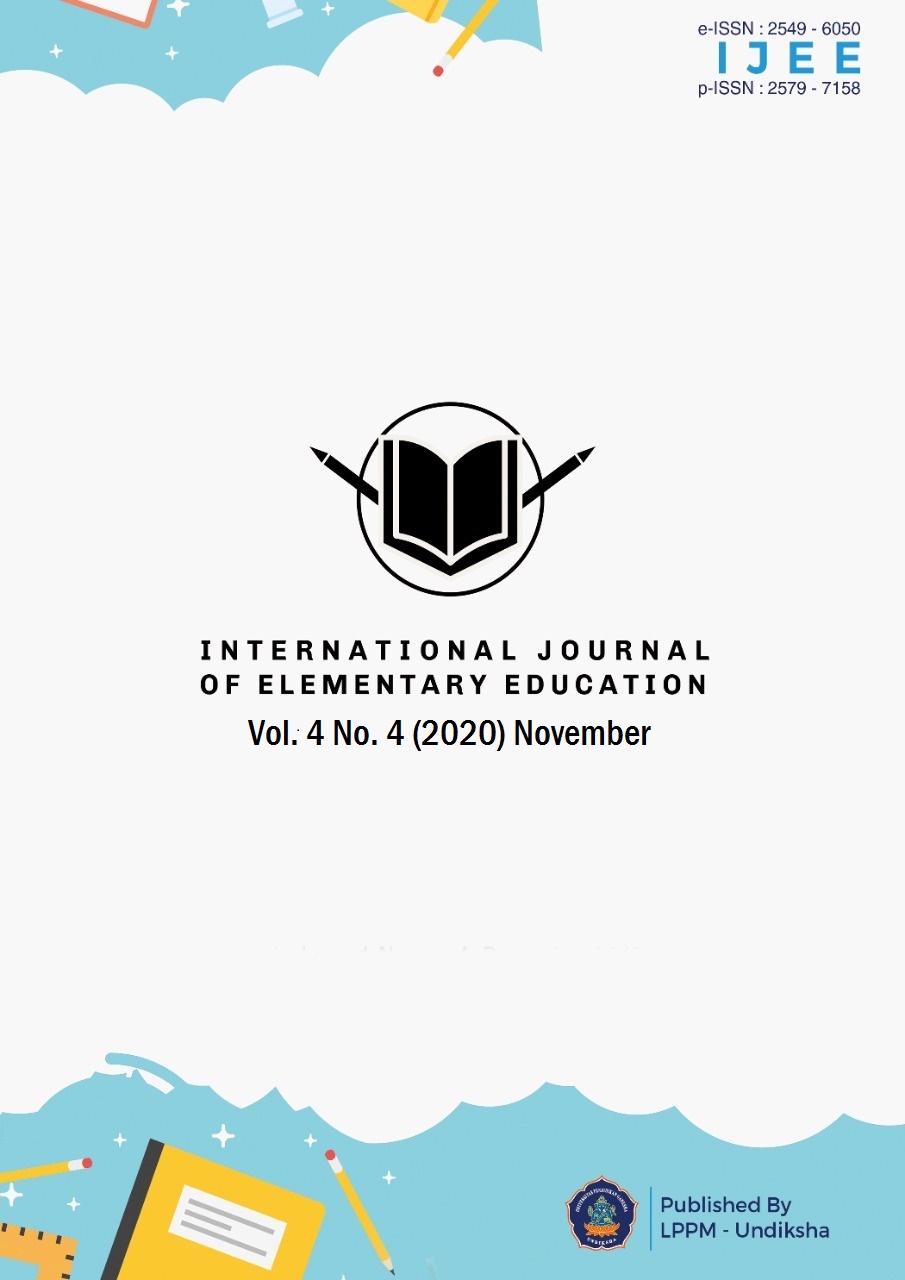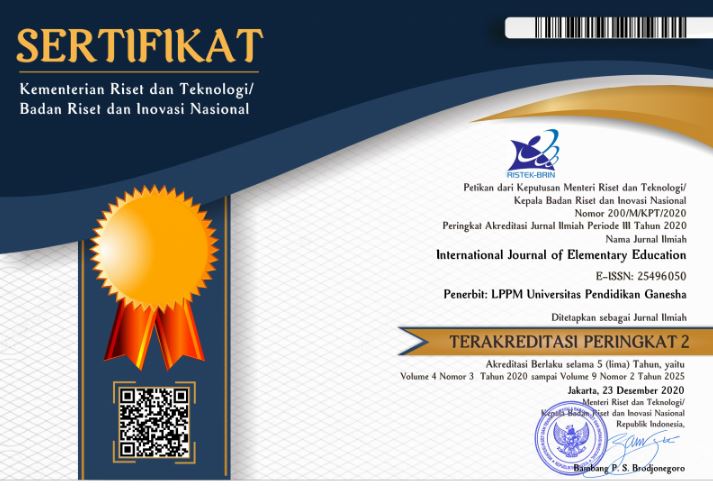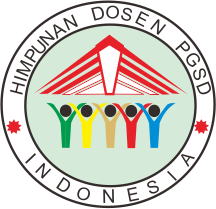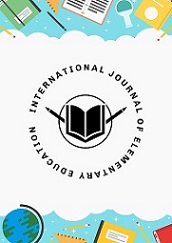The Understanding Improvement of Natural Science Concept of Primary School Teacher Education Department Students Using Project-Based Learning Model
DOI:
https://doi.org/10.23887/ijee.v4i4.28424Kata Kunci:
conceptual understanding, natural science conceptsAbstrak
Based on the results of observations, it was found that the understanding of the concept of students, especially elementary school science material, is very lacking, this is because the learning process is still dominated by presentations and does not provide opportunities for students to explore their own knowledge. This study aims to describe the application of the project based learning model to improve students' conceptual understanding. This research is a classroom action research . The subjects of this study were students of the fourth semester class B which consist of 49 students. Data collection methods in the form of tests and non-tests with the instruments used were observation sheets and test questions. The pre-cycle test results obtained an average value of 64.8 with 47% classical completeness, in the first cycle the average value increased by 74.3 with 74% classical completeness and in the second cycle the average value became 85 with 88% classical completeness. These results indicate that the application of the project-based learning model can improve students' conceptual understanding of elementary schools science materials.
Referensi
Arikunto, S., Suhardjono, & Supardi. (2017). Penelitian Tindakan Kelas. Bumi Aksara.
Asyhar, R. (2014). Kreatif Mengembangkan Media Pembelajaran. Jakarta: Referensi. Referensi.
Darmawan, H. (2014). Peningkatan Kreatifitas Mahasiswa Dalam Merancang Media Pembelajaran Multimedia IPA Berbasis Animasi Melalui Model Cooperative Learning. Jurnal Edukasi, 12(2), 193–204. https://doi.org/10.31571/edukasi.v12i2.155
Dewanti, H., Toenlioe, A. J. E., & Soepriyanto, Y. (2018). Pengembangan media Pop-Up Book untuk Pembelajaran Lingkungan Tempat Tinggalku Kelas IV SDN 1 Pakuaden Kabupaten Ponorogo. Jurnal Kajian Teknologi Pendidikan, 1(3), 221–228. http://journal2.um.ac.id/index.php/jktp/article/view/4551
Dewi, F. (2015). Proyek Buku Digital : Upaya Peningkatan Keterampilan Abad 21 Calon Guru Sekolah Dasar Melalui Model Pembelajaran Berbasis Proyek. Jurnal Metode Didaktik, 9, 1–15. https://doi.org/10.17509/md.v9i2.3248
Fatimah, S. (2017). Analisis Pemahaman Konsep Ipa Berdasarkan Motivasi Belajar, Keterampilan Proses Sains, Kemampuan Multirepresentasi, Jenis Kelamin, Dan Latar Belakang Sekolah Mahasiswa Calon Guru Sd. Jurnal Inovasi Pendidikan Dan Pembelajaran Sekolah Dasar, 1(1), 57–70. https://doi.org/10.24036/jippsd.v1i1.7934
Hairunisa, Arif Rahman Hakim, & Nurjumiati. (2019). Studi Pengaruh Model Pembelajaran Berbasis Proyek (Project Based Learning) Terhadap Kreativitas Mahasiswa Program Studi PGSD Pada Mata Kuliah Konsep Dasar IPA. Jurnal Pendidikan Mipa, 9(2), 93–96. https://doi.org/10.37630/jpm.v9i2.190
Hotimah. (2020). Peningkatan Kreativitas Mahasiswa PGSD dalam Mendesain Media Pembelajaran. Publikasi Pendidikan: Jurnal Pemikiran, Penelitian, Dan Pengabdian Masyarakat Dalam Bidang Pendidikan, 10(2), 168–176. https://doi.org/10.26858/publikan.v10i2.13979
Kurniawan, D. T. (2017). Penggunaan Model PjBL Untuk Meningkatkan Kreativitas Mahasiswa Dalam Membuat Media Pembelajaran Matematika. Kalamatika: Jurnal Pendidikan Matematika, 2(2), 207. https://doi.org/10.22236/kalamatika.vol2no2.2017pp207-220
Kusuma, W., & Dwitagama, D. (2012). Mengenal Penelitian Tindakan Kelas. Indeks.
Laila, A., & Shari, S. (2016). Peningkatan kreativitas mahasiswa dalam pemanfaatan barang-barang bekas pada mata kuliah media pembelajaran. Jurnal Pendidikan Dasar Nusantara, 1(2), 1–15. https://ojs.unpkediri.ac.id/index.php/pgsd/article/view/213
Luh, N., Viana, D., & Kusmariyatni, N. (2020). The Validity of the Pop-Up Book Media on Puberty Topics for Sixth Grade Elementary School. International Journal Of Elementary Education, 4(2), 179–186. https://doi.org/10.23887/ijee.v4i2.25295
Mustika, D. (2017). Pembelajaran Menggunakan Model Learning Cycle 5E untuk Meningkatkan Hasil Belajar IPA di Sekolah Dasar. Jurnal Handayani, 7(2), 1–10. https://doi.org/10.24114/jh.v7i2.7230
Mustika, D., & Ain, S. Q. (2020). Peningkatan Kreativitas Mahasiswa Menggunakan Model Project Based Learning dalam Pembuatan Media IPA berbentuk Pop Up Book. Jurnal Basicedu, 4(4), 1167–1175. https://doi.org/10.31004/basicedu.v4i4.518
Mustika, D., Dafit Febrina, & Sinthya, V. (2020). Peningkatan Kreativitas Mahasiswa dalam Pembuatan Alat Peraga IPA Menggunakan Pembelajaran Berbasis Proyek. Saliha: Jurnal Pendidikan & Agama Islam, 3(1), 31–48. https://staitbiasjogja.ac.id/jurnal/index.php/saliha/article/view/35
Permana, E. P., & Sari, Y. E. P. (2018). Development of Pop Up Book Media Material Distinguishing Characteristics of Healthy and Unfit Environments Class III Students Elementary School. International Journal of Elementary Education, 2(1), 8–14. https://doi.org/10.23887/ijee.v1i1.13127
Pratiwi, E. T., & Setyaningtyas, E. W. (2020). Kemampuan Berpikir Kritis Siswa SD dengan Model Pembelajaran Problem Based Learning dan Model Pembelajaran Project Based Learning. Jurnal Basicedu, 4(2), 379–388. https://doi.org/10.31004/basicedu.v4i4.445
Prilestari, B. D., Zahrulianingdyah, A., & Supraptono, E. (2019). Developing Learning Model “ Project -Based Learning in Improving the Handycrafting Subject for Junior Hgh School .” Journal of Vocational Career Education, 4(1), 67–73. https://doi.org/10.15294/jvce.v4i2.22611
Purwanto. (2016). Evaluasi Hasil Belajar. Pustaka Pelajar.
Rahayu, G. D. S., & Samsudin, A. (2019). Penerapan Model Project Based Learning Dalam Meningkatkan Keterampilan Penyusunan Rencana Pelaksanaan Pembelajaran (RPP) Mahasiswa IKIP Siliwangi. Jurnal Ilmiah P2M STKIP Siliwangi, 6(2). https://doi.org/10.22460/p2m.v6i2p%25p.1447
Rati, N. W., Kusmaryatni, N., & Rediani, N. (2017). Model Pembelajaran Berbasis Proyek, Kreativitas Dan Hasil Belajar Mahasiswa. Jurnal Pendidikan Indonesia, 6(1), 60–71. https://doi.org/10.23887/jpi-undiksha.v6i1.9059
Rusman. (2013). Model-model Pembelajaran. PT Raja Grafindo Persada.
Sastrika, I. A. K., Sadia, I. W., & Muderawan, I. W. (2013). Pengaruh model pembelajaran berbasis proyek terhadap pemahaman konsep kimia dan keterampilan berpikir kritis. E-Journal Program Pascasarjana Universitas Pendidikan Ganesha, 3(2), 194–204. https://ejournal-pasca.undiksha.ac.id/index.php/jurnal_ipa/article/view/799
Suhendar, U., & Ekayanti, A. (2018). Problem based learning sebagai upaya peningkatan konsep matematis mahasiswa. Jurnal Dimensi Pendidikan Dan Pembelajaran, 6(1), 16–19. https://doi.org/10.24269/dpp.v6i1.815
Sumarni, W., Wardani, S., & Gupitasari, D. N. (2016). Project Based Learning (PBL) To Improve Psychomotoric Skills : A Classroom Action Research. Jurnal Pendidikan IPA Indonesia, 5(2), 157–163. https://doi.org/10.15294/jpii.v5i2.4402
Trianto. (2019). Model Pembelajaran Terpadu. Bumi Aksara.
Wena, M. (2016). Strategi Pembelajaran Inovatif Kontemporer. Bumi Aksara.
Unduhan
Diterbitkan
Cara Mengutip
Terbitan
Bagian
Lisensi
Authors who publish with the International Journal of Elementary Education agree to the following terms:
- Authors retain copyright and grant the journal the right of first publication with the work simultaneously licensed under a Creative Commons Attribution License (CC BY-SA 4.0) that allows others to share the work with an acknowledgment of the work's authorship and initial publication in this journal.
- Authors are able to enter into separate, additional contractual arrangements for the non-exclusive distribution of the journal's published version of the work (e.g., post it to an institutional repository or publish it in a book), with an acknowledgment of its initial publication in this journal.
- Authors are permitted and encouraged to post their work online (e.g., in institutional repositories or on their website) prior to and during the submission process, as it can lead to productive exchanges, as well as earlier and greater citation of published work. (See The Effect of Open Access)










